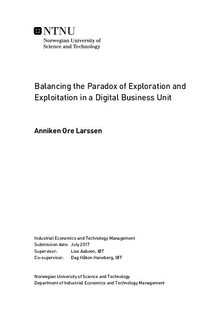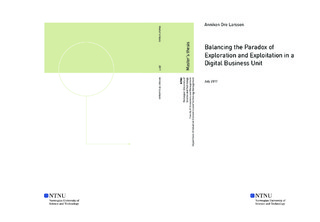| dc.description.abstract | The purpose of this thesis is to understand how the paradox of exploration and explo-
itation is balanced in a digital business unit of a mature firm. Gaining balance between these two contradicting demands has been shown critical to the long-term success and survival of the firm. Despite widespread research on this topic, questions remain unanswered as to how firms achieve this balance in practice. The purpose is approached by taking the managerial and business unit levels of analysis into consideration, as well as by observing interaction effects between these levels of analysis. Thus, three research questions were formulated:
RQ1: How is the paradox of exploration and exploitation balanced at the business
unit level of Digital Business Development?
RQ2: How is the paradox of exploration and exploitation balanced at different
managerial levels of Digital Business Development?
RQ3: How do the managerial and business unit levels influence each other in the
balancing of the paradox of exploration and exploitation?
These research questions formed the basis of a case study of a digital business unit of a mature firm in the financial services sector in Norway: Digital Business Development in Storebrand ASA. In fulfilling the purpose, it is described how the different antecedents interact and complement one another in the business unit s pursuit of organizational ambidexterity. Since the analysis incorporates multiple managerial levels and levels of analysis, this thesis contributes to the research on ambidexterity in organizations spanning multiple levels. In concluding the thesis, it is found that the combination of ambidextrous efforts at the managerial and business unit levels lead to a comprehensive understanding of how the paradox is balanced in the business unit, which provides a holistic perspective on balancing the paradox of exploration and exploitation.
Key findings include how exploration and exploitation can be combined in business units, even in teams, and how managers share the balancing of the paradox. However, several management functions are found to have similar leadership approaches to the paradox, which divides them into two groups: enablers and executors of ambidexterity. Furthermore, some team managers are found to be ambidextrous, but not all individuals of the unit are balancing the paradox of exploration and exploitation. This contributes to the research stream of individual ambidexterity, and contradicts the perspectives of both structural and contextual ambidexterity which respectively argue that paradox tensions belong to either all individuals of the organization or to the top managers only.
Finally, when observing interaction effects between the applied levels of analysis, I identify relationships between transformational and transactional leadership behaviors and exploration/exploitation outcomes. The identified inverted U relationships between transformational leadership and exploration and exploitation have not previously been shown empirically. This contributes to the research stream of ambidextrous leadership by furthering the understanding about how leaders balance the paradox of exploration and exploitation in practice, and how different leadership behaviors affect innovation outcomes in organizations. | |

